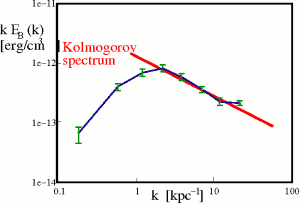|
|  |
The hot (10 million degrees) gas in the centres of galaxy clusters
emits its heat as X-ray radiation allowing the mapping of this gas
with X-ray telescopes (Fig. 1). As soon as the gas has cooled down it
falls into the central galaxy of the galaxy cluster due to gravity. In
its centre a massive Black Hole of a few billion solar masses exists
which injests most of the infalling gas, thereby getting more
massive. At the same time, enormous amounts of energy are released at
the Black Hole by this process and enormous amounts of ultra-hot,
radio-emitting gas are ejected. The ejected gas forms bubbles in the
galaxy cluster (Fig.1 and 2) which rise quickly within the surrounding
cluster gas due to their small density. The surrounding cluster gas
rapidly moves downwards passing the bubbles. The opposing gas
movements lead to turbulence in small eddies eventually providing heat
for the cooling gas in the galaxy cluster. This heating-up prevents
all of the gas from catastrophically collapsing rapidly into the
central galaxy. But the gas collapse is delayed only for a cosmic
moment and then the turbulence decays, the heating power decreases and
the cooling of the gas by radiation of X-rays dominates again. Another
heart beat starts in the galaxy cluster: gas clouds again fall into
the Black Hole and a new cycle begins...
So much to the novel theory about the complex life within the hearts
of clusters of galaxies. What about the confirmation of this theory by
observation? The cooling gas can be observed by X-ray satellites, the
radio emission from the bubbles provides impressive pictures for
terrestrial radio telescopes (Fig. 1) and the gigantic Black Holes can
be inferred from other observations. But is there really turbulence in
the cooling gas which eventually heats it up again? Direct evidence
was missing until now.
An indirect proof was provided through the detection of magnetic
turbulence in the gas of the Hydra cluster of galaxies by Corina Vogt
and Torsten Enßlin at the Max-Planck-Institute for Astrophysics. The
movements of the gas in galaxy clusters should stretch, wrap up and
amplify the magnetic fields interwoven within the gas. The theory
predicts that the magnetic eddies are somewhat weaker and smaller
compared to the gas eddies. Therefore, a measurement of the magnetic
eddies provides information about the turbulence in the gas.
The measurement of the magnetic turbulence was realised by a
statistical analysis of a so-called Faraday rotation map. Faraday
rotation is the rotation of the polarisation direction of the radio
emission when passing through magnetised gas. The strength of the
rotation is dependent on the strength of the magnetic fields along the
path of the radio radiation. This Faraday rotation can be measured by
multi-frequency observations with radio telescopes. These maps yield a
two dimensional image of the three dimensional magnetic fields between
the source of the radio emission and Earth (Fig. 3). Observations of
the radio bubbles in the Hydra cluster of galaxies therefore allow the
mapping of the magnetic fields residing within the cluster
(Fig. 4). This map already gives an impression of the chaotic magnetic
field structure. But are the magnetic fields as turbulent as expected
by the theory of gas motion?
A detailed, statistical analysis of the Faraday rotation map shows
that the typical length scales and the typical magnetic field
strengths match the expected but unobserved gas turbulence
(Fig. 4). The strongest magnetic eddies reach about 10,000 light years
and are, as expected, smaller than the radio bubbles which are about
30,000 to 100,000 light years in size. The strength of the magnetic
eddies are also, as expected, one hundred thousandth of the Earth's
magnetic field (the latter being about one Gauss). Furthermore, the
statistics of the small magnetic field eddies follow a
Kolmogorov-spectrum which is universally valid for gas turbulence. The
statistics indicate to which degree the strength of the turbulent
eddies lessens with decreasing scales of the eddies
(Fig. 5). Practically, the Kolmogorov-spectrum is the fingerprint of
turbulent gas motions. The discovery of the Kolmogorov-spectrum as
revealed by the statistics of magnetic eddies means that the
turbulence suspected in the gas of the Hydra cluster of galaxies is
actually present there and thus, provides the surrounding gas with
heat even as heat escapes from the gas by X-ray emission cooling. - A
first confirmation of the new theory about flows of energy and matter
in the hearts of galaxy clusters.
Torsten Enßlin, Corina Vogt
Further information:
C. Vogt, T.A. Enßlin:
 A Bayesian view on
Faraday rotation maps - Seeing the magnetic power spectra in galaxy
clusters, 2005, A&A, 67, 434. A Bayesian view on
Faraday rotation maps - Seeing the magnetic power spectra in galaxy
clusters, 2005, A&A, 67, 434.
T.A. Enßlin, C. Vogt:
 Magnetic
turbulence in cool cores of galaxy clusters, 2005, A&A,
submitted. Magnetic
turbulence in cool cores of galaxy clusters, 2005, A&A,
submitted.
|




